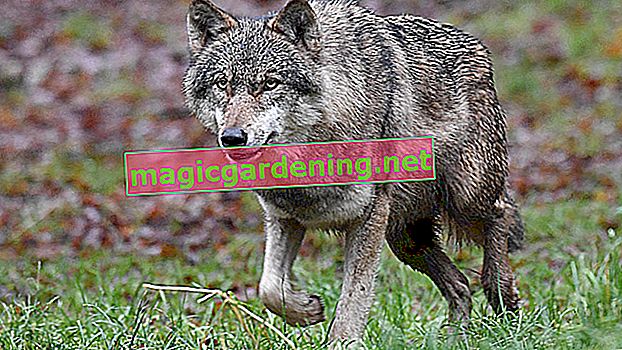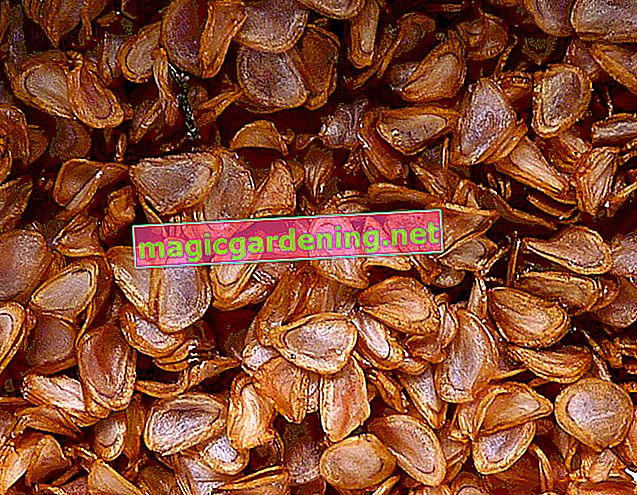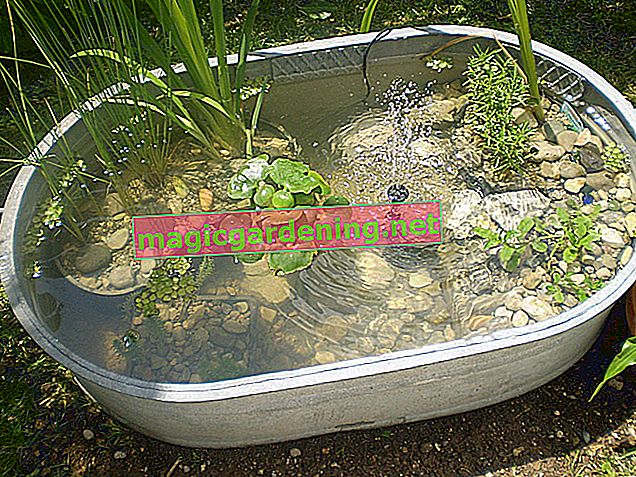
Types of cuts and dates
Annual pruning of blueberries is not mandatory. In contrast to raspberries or blackberries, wild blueberries (Vaccinium myrtillus) and cultivated blueberries (Vaccinium corymbosum) can easily be grown. However , if you use scissors once a year , the effort will be rewarded with a higher harvest yield and larger blueberries. The following table provides an overview of recommended cut types and the best date in each case:
also read
- Hibernate blueberries in the garden
- Cut hanging willow vigorously once a year - this is how it works
- Blueberries - season and harvest
| Cut type | Goal / occasion | best date |
|---|---|---|
| Upbringing | Build a high-yielding shrub | 1st to 3rd year in February |
| Conservation cut | Maintain profitability | from the 4th year February to the beginning of March |
| Taper cut | Revitalize neglected blueberries | Late winter |
Digression
Better cut blueberries north of the Alps in February
With a cut in February you will make the best choice of date for your blueberry. In mild winter regions of hardiness zones 7, 8 and higher, there is the option of pruning the berry bush immediately after harvest. For regions in winter hardiness zones 6 and 5, an autumn appointment is associated with the risk that a naturally hardy blueberry will freeze back heavily. It cannot be ruled out that the plant will sprout fresh after cutting, which significantly affects its natural frost hardiness.Raising blueberries properly
With 5 to 8 ground shoots , a blueberry bush is well positioned for a rich harvest with large, juicy fruits. A framework with more than 10 bottom shoots will also give you delicious blueberries. However, you must expect that the fruits are small and low in juice. We therefore recommend the following cutting training from the year of planting to the beginning of the yield phase in the second or third year of standing. How to proceed professionally:
- Build up the shrub structure with 5 to 8 vital ground shoots (maximum 10)
- Remove excess ground shoots
- In the first and second year, cut or break off all flowers on the peduncle
It is undoubtedly difficult to remove the flowers in the first two years and thus do without a juicy blueberry harvest. Nevertheless, we recommend trying to get through this intervention in growth. As a result, the berry bush invests all of its energy in strong roots and healthy, high-yield growth.
Tips
Planting too deeply takes away your courage to face life. Place the root ball so that it protrudes about two fingers' breadth from the substrate. Cover the exposed root area with bark mulch or leaf compost, which can be up to 20 centimeters thick in autumn planting as natural winter protection.
Instructions for the maintenance cut
An annual maintenance cut continues in a modified form what you started with the education. The aim of pruning is continuous rejuvenation by replacing older ground shoots with young wood. If unfavorable brooms form at the tip of the shoots with increasing age, a skilful derivation cut can help. How to properly cut established blueberries:
- The best time is in February on a frost-free day
- At the beginning, cut out dead, inward or cross-growing branches
- Broom-like branched shoot tips slim down to a lower side branch
- From the 4th year of standing, remove at least one old scaffold drive
- Use the most promising vertical ground shoot (s) as successors
- Remove excess ground shoots at the base
The entire blueberry bush benefits from continuous regeneration . As the oldest scaffold shoot makes room for a young bottom shoot every year, you also promote the growth of young, annual side branches as the most valuable fruit wood. At the same time, in later years you will not feel compelled to put an overaged blueberry on the cane and, as a result, to forego delicious blueberries from your own harvest for several years.
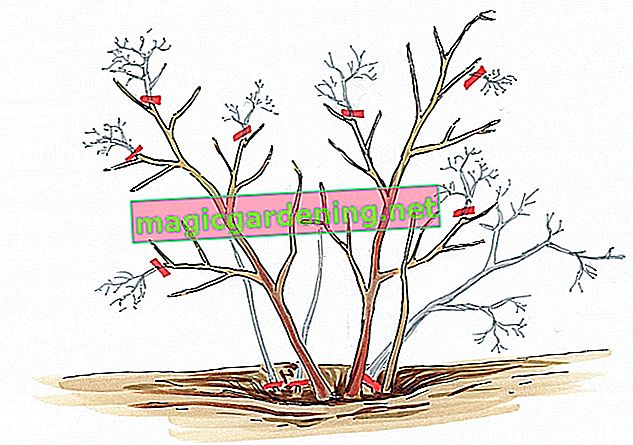
background
Promoting young fruitwood - instructions for the derivation cut
The thickest and sweetest blueberries thrive on the annual side shoots on the bushes. A derivation cut clears the way so that old, worn branches do not shade the young fruit wood or deprive it of important nutrients. You can recognize old wood by its strongly branched, drooping growth and gray-brown, bark-like bark. Look along the old shoot for a young side shoot with a green, smooth bark. Place the secateurs at the fork between young and old wood. The figure below illustrates the important cutting technique, which is of decisive importance for all fruit trees.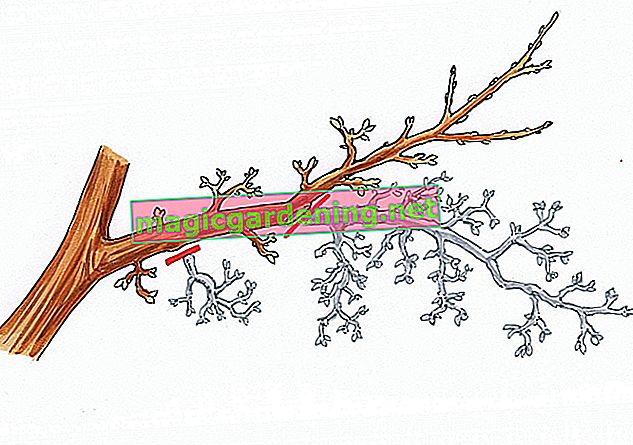
Rejuvenate old blueberry bush
Blueberries can reach a proud age of up to 40 years. It can easily survive so much concentrated vitality if the incision care has been neglected for several years. If you have taken over an old blueberry bush, you can bring new momentum to growth with a powerful rejuvenating cut. This is how it works:
- The best time is in late winter
- First cut off all dead ground shoots at the base
- Cut the remaining shoots back to 30 to 35 centimeters
After a total pruning, a blueberry bush recalls its “iron reserve”. Specifically, these are sleeping eyes that slumber almost invisibly under the gray, barked bark. By radically shortening the berry bush, the dormant buds are revitalized. In combination with a good portion of leaf compost and horn shavings, a fresh shoot sets in, which you can use to rebuild.

frequently asked Questions
Are blueberries self-fruiting?
That's the way it is. A blueberry bush bears fruit without any conspecifics nearby. However, it is highly recommended to keep at least two blueberries together. This not only increases the yield. By placing the early-ripening variety 'Earlyblue' next to the medium-early variety 'Bluecrop' and the late blueberry 'Goldtraube', the time window for the harvest remains open longer.
How long does it take for a freshly planted blueberry to bear fruit for the first time?
As a rule, young blueberries will fruit for the first time in the second or third year after planting. The yield is significantly improved from the start if you plant several varieties in the garden.
I would like to grow blueberries on my balcony. Which variety is suitable for this? How big should the pot be?
All blueberry varieties love a place in partial shade. For the west or east balcony or in a shaded niche on the south balcony you have the free choice. A bucket with at least 10 liters volume is big enough to grow blueberries in it. Please make sure to use a slightly acidic substrate, such as rhododendron or bog soil.
My three blueberry bushes bear only a few, measly fruits. I suspect the cause is an unsuitable location. When and how can I transplant the berry bushes?
Blueberries prefer a sunny to partially shaded and not too hot location. A humus-rich, well-drained garden soil with a pH value of 4.0 to 5.0 is perfect. The best time to change location is in autumn after the leaves have been shed. Cut off the root ball in a radius that is at least half the circumference of the bush. At the new location, ideally prepare the planting pit with bog soil or a mix of leaf compost, sand and clay and a handful of horn shavings. (€ 6.39 at Amazon *)
Many branches of my two-year-old blueberry have dried out at the tips and have brown leaves. What are the causes? What can I do?
It is difficult to diagnose the described damage without looking at the shrub. You should consider the following causes: waterlogging, pH value too high (greater than 5.5), compacted soil, drought. If one of the three first-mentioned triggers applies, we recommend cutting back the blueberry bush into the healthy wood and replanting it or changing the soil. Regular watering with soft rainwater helps against drought.
The 3 most common mistakes
When cutting blueberries, joys and sorrows go hand in hand. A pruning at the wrong time dampens the joy of harvesting just as much as an incorrect pruning. So that you do not have to worry about unnecessary problems with blueberry bushes, the following table draws attention to the three most common cutting errors and gives tips for skillful prevention:
| Cutting errors | Damage | prevention |
|---|---|---|
| never exposed | aged, impenetrable growth | clear every year from the 4th year onwards |
| no parental cut | densely branched shrub with few, small fruits | Build up the blueberry with 5 to 8 strong ground shoots |
| cut after the flowering period | little or no fruit | always cut in February |
Tips
Blueberries have an aversion to lime in any form. Plant the berry bushes in acidic soil with a pH value between 4 and 5. So that no lime accumulates in the soil, please always water the thirsty blueberries with rainwater or well-stale tap water.

